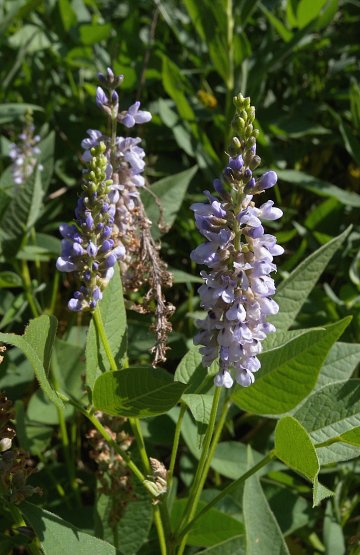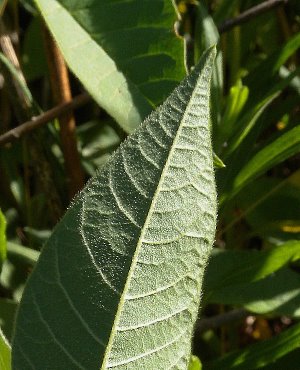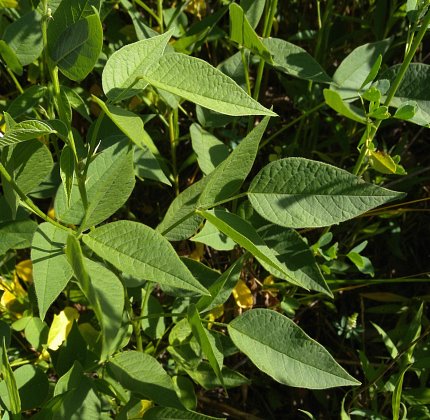
Both axillary and terminal racemes of flowers are produced on peduncles about 2-8" in length. These racemes are 2-6" long and spike-like in appearance; the density of flowers along each raceme is intermediate. The central stalk of each raceme is pale green and sparsely covered with short fine pubescence. Each flower is about ¼" long and relatively narrow in shape, consisting of 5 blue, purple, or nearly white petals, a short-tubular calyx with 5 teeth, and the reproductive organs. The petals form an upright banner, a pair of forward-projecting wings, and a small keel that is largely hidden by the wings. At the base of the banner, there is a small patch of yellow with fine purple veins. The calyx is pale green to pale purplish yellow and sparsely short-pubescent. The pedicels of the flowers are very short (less than 1/8" in length). The blooming period occurs from late spring to mid-summer, lasting about 1 month. Afterwards, the flowers are replaced by short seedpods about 8-12 mm. long. These seedpods are obovoid, somewhat compressed (flattened), and asymmetric (more curved on one side
 than the other); they are
single-seeded. Individual seeds are 4-6
mm. long, reniform (kidney-shaped), and somewhat compressed, becoming
dark brown at maturity. The root system is rhizomatous, often forming
clonal colonies of plants.
than the other); they are
single-seeded. Individual seeds are 4-6
mm. long, reniform (kidney-shaped), and somewhat compressed, becoming
dark brown at maturity. The root system is rhizomatous, often forming
clonal colonies of plants.Cultivation: The preference is full or partial sun, mesic to dry-mesic conditions, and loamy soil. This wildflower can be propagated by seed or division of its rhizomes.
Range & Habitat: The native French Grass is uncommon to occasional in central Illinois, becoming rare or absent in the southern and northern sections of the state (see Distribution Map). It is found primarily in the lower Midwest (Illinois, Indiana, Ohio, and eastern Missouri). Habitats include black soil prairies, pioneer cemetery prairies, lower slopes of hill prairies, riverbanks, upland open woodlands, poorly maintained embankments along country roads, and fallow fields. French Grass is found in both high quality habitats (mostly prairie remnants) and more disturbed habitats that have a history of neglect.
Faunal Associations: Aside from flower-visiting insects, very little is known about floral-faunal relationships for this species. Robertson (1929) observed honeybees, bumblebees, cuckoo bees (Coelioxys spp.), leaf-cutter bees (Megachile spp.), mason bees (Osmia spp.) Halictid bees, plasterer bees (Colletes spp.), Sphecid wasps, Vespid wasps, bee flies (Bombyliidae), thick-headed flies (Conopidae), butterflies, skippers, and moths visiting the flowers for nectar. Some of the bees also collected pollen from the flowers. Robertson also observed an uncommon carder bee, Anthidium psoralaeae, visiting the flowers of French Grass. This latter bee is an oligolege (specialist pollinator) of some prairie species (Orbexilum spp., Psoralidium spp., etc.) in the Bean family. There is also a newly discovered, but still unnamed, moth caterpillar (Schinia sp.) that feeds on French Grass in the lower Midwest. This caterpillar is pale yellowish green with pairs of large black dots along its sides.
Photographic Location: An overgrown embankment along a gravelly road in Vermilion County, Illinois.

Comments: In spite of the common name, this species is a legume in the Bean family, rather than a grass. The foliage of French Grass has a striking similarity to the foliage of cultivated Soybeans (Glycine max). However, both the inflorescences and seeds of these two species bear little resemblance to each other. French Grass appears to be a species that is often neglected in prairie and savanna restorations, even though it is probably not difficult to cultivate. Another species that is native to Illinois, Orbexilum pedunculatum (Sampson's Snakeroot), is a smaller plant with more narrow leaves and its flowers are usually more white or pinkish white than those of French Grass. Sometimes 'Sanfoin' is used as a common name for Orbexilum onobrychis. A scientific synonym of this species is Psoralea onobrychis.